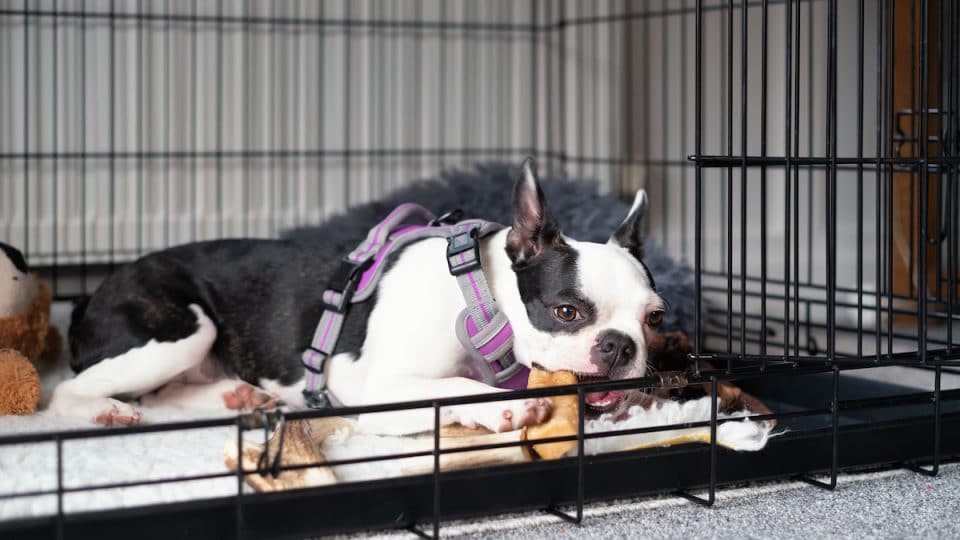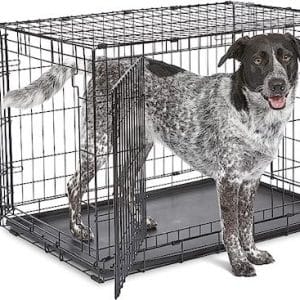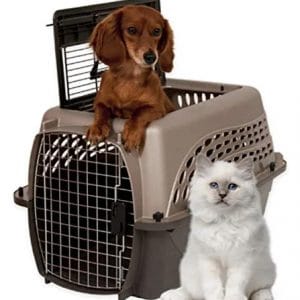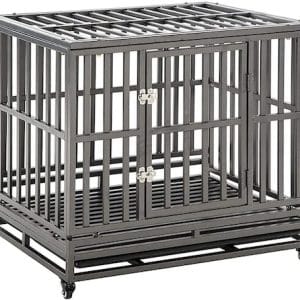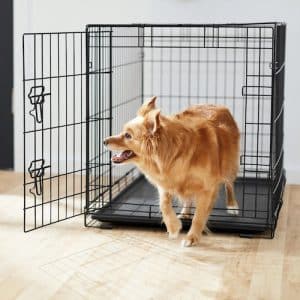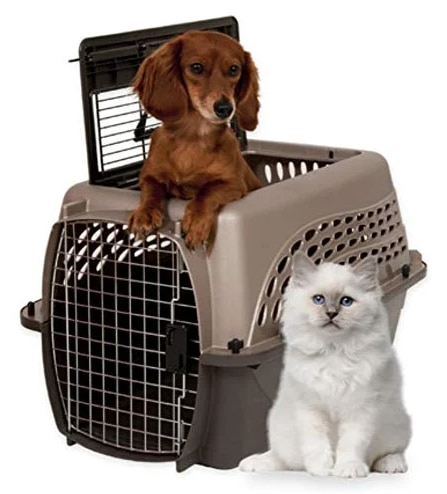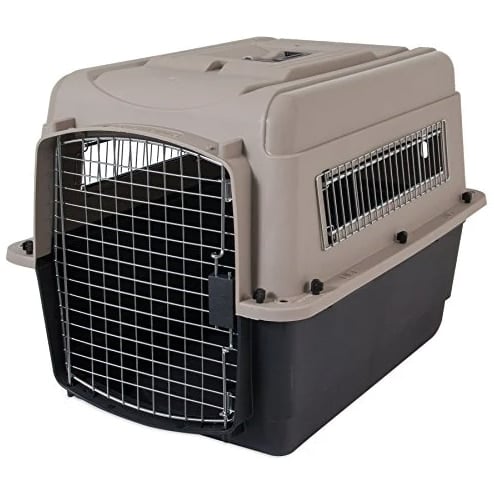- This review contains affiliate links. Read more here.
- Not a substitute for professional veterinary help.
Vet Reviewed by Jenny Alonge, DVM, FFCP on 3/14/25
If you have a new puppy running around your home, a good dog crate can be one of the handiest tools in your kit. A crate for puppies keeps your new friend safe during brief periods when you can’t keep an eye on them, reduces the chances of mischief, and can help with potty training.
If you’re new to the world of crates or this is your very first dog, crate training a puppy can be daunting. But finding the best crate for your pup is a great place to start and can even make the crate training process go much more smoothly.
When choosing a crate for your puppy, there’s no one-size-fits-all option. The type you choose will depend on your puppy’s size and needs. “Remember: The best crate setup is one that works for you and your puppy,” says Alicia Collins, a certified animal care operator and founder and CEO of K9 Activity Club. Keep reading to learn more about the different types of crates to choose from for your pup.
Our picks
How To Choose a Puppy Crate
When choosing a puppy crate, you’ll want to consider:
- the crate’s chew resistance and materials (especially if your puppy is in the chewing phase)
- how easy it is to clean (because accidents and messes will happen)
- whether it comes with adjustable sizing or dividers to fit your puppy both now and when they’re grown
There are three main types of crates available: fabric (sometimes called “soft”), solid-sided, and wired. When it comes to using a fabric crate, Collins notes she usually only does this with smaller breeds and when she can supervise the pup in the crate.
Solid-sided crates include plastic, plastic with wire, steel, or aluminum crates that are almost entirely enclosed to create a den-like space for your pup. “These can help anxious dogs feel more comfortable by acting as a hiding place,” says Collins. The only downsides? These crates don’t always have the option to adjust the size, and they can be trickier to clean.
Wire crates are a popular choice that come in many sizes and strengths. They are often adjustable (lots come with “puppy dividers” to help make the crate smaller) and collapsible, making them convenient for travel.
How we chose
The puppy crates featured here were selected based on a combination of our own hands-on testing, a comprehensive look at customer reviews across a wide variety of retail platforms, and interviews with veterinary experts. We prioritized crates with puppy-friendly attributes, such as durability and security. We’re also guided by the experience of living and playing alongside our own much-loved and strongly opinionated puppies, who are never stingy with their feedback.
Best Overall: MidWest iCrate Double Door Folding Metal Dog Crate
Key Features:
- Removable plastic tray that’s simple to clean
- Double doors for easy access
- Comes with a divider for growing puppies
- Lightweight and portable
- Affordably priced
- Available in multiple sizes
The popular MidWest iCrate offers a lot of convenient features for crate training your puppy. The removable plastic tray slides out easily, making accident cleanup a breeze. The double doors let your puppy move in and out freely when you’re first introducing them to the crate. And best of all, the crate comes with a divider that lets you size your puppy’s space to just what they need—an essential feature for potty training.
Pet parents like how simple the lightweight crate is to set up, take apart, and move, which is great for figuring out the best spot to place the crate in your house. Some reviewers report that the doors bend when pulled hard, which should be fine unless you have a determined escape artist.
Best for Small Breeds: Petmate Two Door Top Load Pet Kennel
Key Features:
- Available in three sizes made for smaller breeds
- Suitable for most air travel (check with your airline)
- Well-ventilated with multiple air holes on each side
- The top door makes it easy to get your small pup in and out of the crate
Made specifically for smaller pets, this kennel offers two sizes ideal for small-breed puppies. The 19-inch crate fits puppies up to 10 pounds, while the 24-inch suits pups up to 15 pounds. The 14-inch crate is best for cats and other small pets but could also work for tiny toy breeds.
Ventilation holes on each side allow air to circulate, while a second door on top provides another access point. Pet parents like the sturdy build and say the size works great for their smaller pups—even longer breeds like Dachshunds. Reviewers also say this crate is a solid option for travel, noting that the top door is great for easily getting their pup out for potty breaks.
Best for Large Breeds: KELIXU Large Heavy Duty Dog (Verified Review)
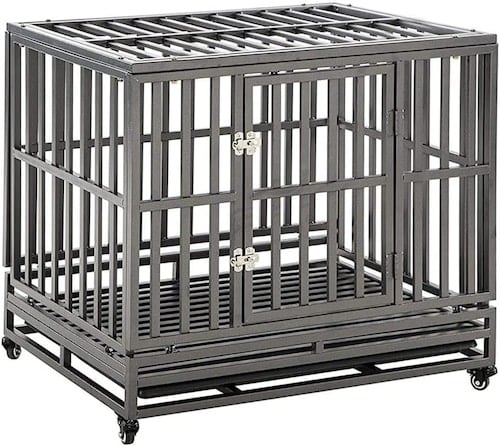
KELIXU Large Heavy Duty Dog
This heavy-duty crate will contain big dogs, escape artists, and particularly destructive puppies.
Key Features:
- Multiple entry points
- Large and heavy; not portable
- Lockable wheels; wheels allow for 360-degree rotation
- Comes with a removable plastic tray for easy cleaning
This heavy-duty dog crate made of welded steel bars is ideal for large breed puppies, escape artists and chew-loving pups. It features an “anti-escape” lock and is easy to move with fully rotational locking wheels. The bars allow for almost full visibility and airflow, which can be a perk for some dogs. If your dog is easily overstimulated, a crate cover helps provide less visibility.
A Rover Kelixu tester noted this crate is nice because it comes in several large sizes and doesn’t have sharp edges. They also liked that there are multiple openings for easy entry and exit. And for non-chew loving dogs, a cozy crate bed can be added for comfort.
Best for Travel: Petmate Ultra Vari Kennel
Key Features:
- Material and construction make chewing difficult
- Good for travel with less visibility
- Easy to clean hard plastic surface
- Compatible with most airline cargo requirements (check your airline)
- Rounded edges
This crate, made from recycled plastic, wins the top spot for our travel crate pick due to being sturdy, easy to clean, and useful in various settings. You can strap it into the back seat via tie-down holes for safe car travel, fly your pet in it, or set it up in the living room for an at-home den. And it’s ideal for puppies who gnaw on the sides of wire crates or wind down better with fewer visual stimuli—they can see out, but not all around like in a wire crate.
While it doesn’t fold like some of its wire counterparts, you can take it apart in two pieces if needed with no tools required.
Best Upgrade: Diggs Evolv Dog Crate (Verified Review)

Diggs Evolv Dog Crate
The Diggs Evolv crate is a slimmer, more budget-friendly version of the popular Revol, with doors that extend to create a playpen.
Key Features:
- Rounded edges, puppy-proof locks, and diamond mesh all promote pup safety
- Two side doors and a top opening can be rearranged to form a playpen; extra doors are available for purchase
- Finger-friendly handles for opening doors
- Available in four sizes, with divider and removable tray
- A little bigger and heavier than a traditional wire crate
The new Diggs Evolv is an updated take on the classic Revol, built along slimmer lines and with a novel new feature: the ability to convert it into a playpen with the addition of an extra frame. It’s roughly as sturdy as the Revol, with a steel body and diamond wire mesh meant to prevent pinched paws and jaws.
A puppy divider and a removable bottom tray make this especially nice for growing dogs or pups in crate training, and the lower price point is a little friendlier to new pet parents still getting the lay of the land and discovering their dog’s preferences. Rover test puppy Blue loves his crate, and his pet parent appreciated both the functional aesthetic and the extremely simple assembly.
Our only caveat? The Evolv doesn’t collapse flat, which might make the Revol a better option for pet parents who like the brand but need something more portable.
Best Budget Option: Frisco Fold & Carry Single Door Collapsible Wire Dog Crate
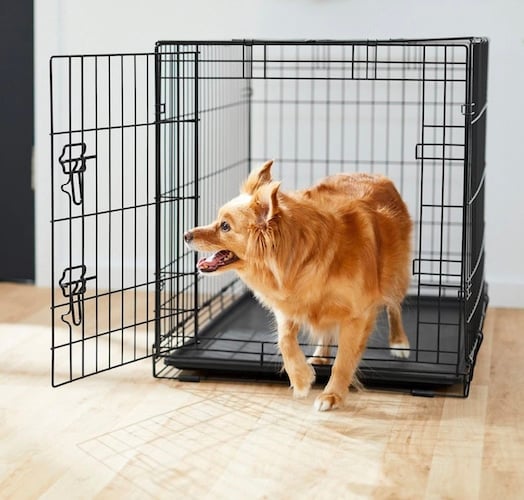
Frisco Fold & Carry Single Door Collapsible Wire Dog Crate
This Frisco wire crate offers a basic kennel for pet parents looking for something a bit more affordable.
Key Features:
- Basic single-door, wire crate design
- Budget-friendly option
- Includes a removable base pan and a divider
- Available in seven different sizes
For something more budget-friendly, the Frisco Fold & Carry wire crate offers the basics of a standard kennel. It’s an excellent option for pet parents of rescues who are unsure of how big their pup will get or just anyone looking to save a bit of cash.
Similar to the MidWest iCrate, this Frisco kennel has a removable base pan that’s easy to clean and a divider to block off space as your puppy grows. It only has one door, however, which latches securely with two locks. Pet parents like the affordable price point, with reviewers saying they’re pleased with the value this crate offers.
What Else Goes in a Crate?
As your puppy learns to use their crate, you may want to start with the bare minimum to prevent chewing or swallowing something they shouldn’t. A soft blanket or puppy bed can help make the space more comfortable.
As your pup ages and you learn more about their behaviors, you can include more things in your puppy’s crate, like puppy toys that aren’t a choking hazard may also be an option. “Remove harnesses, collars, and tags before crating to prevent them from getting caught and posing a safety risk,” advises Collins.
Puppy Crate FAQs
How do I stop a puppy from pooping and peeing in the crate?
Puppies are bound to have accidents during potty training. The best way to prevent accidents is by staying on top of your potty training schedule, not keeping your pup in the crate too long, and taking them for potty breaks before and after putting them in the crate.
How long can a puppy stay in a crate?
This will depend on their age and bladder control. Younger puppies (under 6 months) require frequent bathroom breaks, as their bladders are good for 1-3 hours at the most. “The maximum recommended time a puppy can be left in a crate is one hour per month of age,” says Collins. Around 6 months, puppies can hold their pee for more extended periods, on average up to 6 hours.
What if my puppy hates the crate?
Crate training a puppy often takes time and patience. Continue making the crate a positive experience and slowly build up your puppy’s time in it. Then, follow up with positive reinforcement, like praise or a favorite treat.
Not going well? Consider calling in a professional trainer to help you work out the bugs.
Is a soft or hard crate better?
This will depend on your puppy and their behavior. While lightweight and portable, soft crates can be easier to escape and aren’t the best option for chewers. They’re also harder to clean. Collins notes soft crates tend to have mesh sides, so they’re more open and less visually restrictive—which may be both a pro and con for certain pups.
Do vets recommend crates?
Most vets agree that crate training can be a good option for most dogs—but it’s not a good solution for everyone. Depending on your dog’s personality, crate training may not be the right fit for you and your pup.
